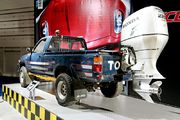Toyota Hilux
_SR5_Xtra_Cab_2-door_utility_01.jpg) |
|
| Manufacturer | Toyota Motor Corporation Toyota Motor Argentina S.A. Toyota Motor Thailand Co., Ltd. Hino Motor NUMMI (1991-1995: North America) |
|---|---|
| Also called | Toyota Pickup Toyota Tacoma |
| Production | 1968–present |
| Predecessor | Toyopet Light(Stout) Toyota / Hino Briska |
| Successor | Tacoma (Japan and North America) |
The Toyota Hilux and Toyota Tacoma are a series of compact pickup trucks produced and marketed by the Toyota Motor Corporation. The Hilux name was adopted as a replacement for the Stout in 1969, and remains in use worldwide. In North America, the Hilux name was briefly retired in 1976 in favor of Truck, Pickup Truck, or Compact Truck, until it was renamed Tacoma in 1995. One popular option package, SR5 (Sport Rally 5-Speed), also became synonymous with the truck, even though the option package was also used on other Toyota models as well. In 1984, the Trekker, the camper version of the Hilux, was changed to the 4Runner in Australia and North America, and as the Hilux Surf in Japan. The 4Runner is now a full SUV, and the more recent models do not resemble the Tacoma.
Contents |
Predecessor
1935
The original Toyota pickup was the 1935 Type G1 truck. It shared many components with the company's Type A1 sedan, and was a 1.5 ton stake-bed commercial truck.
1947
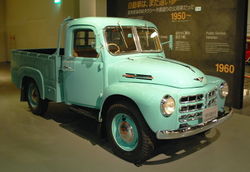
After World War II, Toyota returned with a compact pickup truck, the Toyopet Model SB. This was the ancestor of the Stout, and remained in production from 1947 through 1957.
Engine:
- 995 cc I4, 27 hp (20 kW)
1960
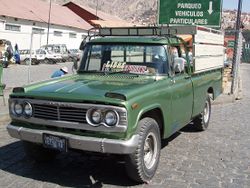
Toyota introduced the second generation Stout. Although it was similar in design to Datsun and Mazda compact trucks, it was larger.
Engine:
- 1964-1968 - 1.9 L (1897 cc) 3R I4, 85 hp (63 kW)
First generation
| Also called | Hilux Pickup |
|---|---|
| Production | 1968–1972 |
| Assembly | Toyota City, Japan |
| Body style(s) | 2-door truck |
| Layout | FR layout |
| Engine(s) | 1.9 L I4 1.8 L I4 |
| Transmission(s) | 4-speed manual |
The Hilux started production in March 1968[1] as the RN10 in short wheelbase form with a 1.5 L engine. This was upgraded to a 1.6 L I4 engine in February 1971.
Global markets:
- 1968-1971 - 1.5 L (1490 cc) 2R I4[1]
In April 1969, a long wheelbase version was added to the range. The short wheelbase version also continued in production for many more years. The long wheelbase version was not sold on the North American market until 1972.
In spite of the name "Hilux", it was a highly-luxurious vehicle only when compared to the Stout. Hilux was engineered and assembled by Hino Motors to augment the Hino Briska, Briska and Stout or to replace them in some markets. For the North American market, the only body style was a regular cab short bed and all were rear-wheel drive. It used a typical truck setup of A-arms and coil springs in front and a live axle with leaf springs in back. A 4-speed manual transmission was standard.
Global markets:
North American markets:
- 1969 - 1.9 L (1897 cc) 3R I4, 85 hp (63 kW)
- 1970-1971 - 1.9 L (1858 cc) 8R SOHC I4, 97 hp (72 kW)
- 1972 - 2.0 L (1968 cc) 18R SOHC I4, 108 hp (81 kW)
Second generation
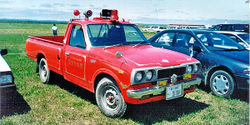 |
|
| Production | 1972–1978 |
|---|---|
| Assembly | Toyota City, Japan Hino |
| Body style(s) | 2-door truck |
| Layout | FR layout |
| Engine(s) | 1.5 / 1.8L I4 |
| Transmission(s) | 5-speed manual |
In the middle of 1972, the 1973 Hilux was released as the RN20. A more comfortable interior was specified along with exterior updates. A 7.5 ft (2.3 m) "long bed" an option for the first time in North America, although it had been available worldwide since April 1969.[1]
Global markets:
North American markets:
- 1973-1974 - 2.0 L (1968 cc) 18R SOHC I4, 108 hp (81 kW)
The truck was radically redesigned in 1975. Larger and more luxurious, the truck also introduced the 20R engine and SR5 upscale trim package. A 5-speed manual transmission was optional. The Hilux name was dropped in North America in favor of "Truck" the next year.
Engine:
- 1975-1980 - 2.2 L (2189 cc) 20R SOHC I4, 96 hp (72 kW)
Third generation
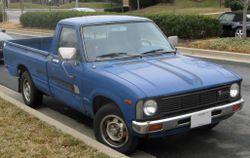 |
|
| Also called | Pickup (US) |
|---|---|
| Production | 1979–1983 |
| Body style(s) | 2 and 4-door truck |
| Layout | Front engine, rear-wheel drive / four-wheel drive |
| Engine(s) | 2.0L I4 2.2L I4 2.2L-D I4 |
| Transmission(s) | 5-speed manual< 4-speed manual 3-speed automatic |
| Related | Toyota Trekker |
In North America the Hilux saw the use of four wheel drive. It had a solid front axle and leaf suspension. The body saw a redesign that included single round headlights and a less complex body. These trucks became known as first generation 4WDs. It was the first Hilux with automatic transmission.
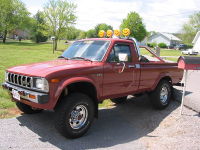
In 1981 a vehicle development agreement was established between Toyota, Winnebago Industries and two other aftermarket customizers. This was to allow Toyota to enter the SUV market in North America. The vehicles which resulted from this collaboration were the Trekker (Winnebago), Wolverine, and the Trailblazer (Griffith). All three used the Hilux 4x4 RV cab and chassis, and an all-fiberglass rear section (the Trailblazer had a steel bed with a fiberglass top). There were at least 1,500 Trekkers, 400 Trailblazers and an unknown number of Wolverines sold in North America. Research and development work on the Trekker lead to the development of the 4Runner, which was released in 1984. The 4Runner was sold in Australia, North America and the United Kingdom; in some other markets, such as Japan, it was called the Hilux Surf.
Toward the end of the SR5's production run (1983½ model year), Toyota introduced the luxury Mojave for the US market as a limited-production (3,500 units) model with options not available on any other Toyota pickup.[2] List priced at US$8,308,[2] it featured bucket seats, two-speaker multiplex radio, chrome front and rear bumpers, and no Toyota logo on either the grille or tailgate.[2] Cruise control, power steering, and air conditioning were optional.[2] It was powered by the SR5's standard 2.4 l (150 cu in) inline four.[2]
Engines:
- 1981-1983-2.4 L(2366 cc) 22R SOHC I4, 96 hp (72 kW) at 4800 rpm and 129 ft·lbf (175 N·m) of torque at 2800 rpm.
- 1981-1983-2.2 L Diesel I4, 62 hp (46 kW) at 4200 rpm and 93 ft·lbf (126 N·m) of torque (SR5 long bed only).
- 1981-1983-1.8 L preflow 4 speed manual (Australia)
Fourth generation
 |
|
| Also called | 1 Ton |
|---|---|
| Production | 1984–1997 |
| Model year(s) | 1985–1989 |
| Assembly | Toyota City, Japan Tahara, Aichi, Japan Montevideo, Uruguay, South America |
| Body style(s) | 2 and 4-door truck |
| Layout | Front engine, rear-wheel drive / four-wheel drive |
| Engine(s) | 2.4L I4 3.0L V6 2.4L-D I4 |
| Transmission(s) | 4/5-speed manual 3-speed automatic |
| Wheelbase | Regular Cab Short Bed: 103.0 in (2616 mm) Regular Cab Long Bed: 112.0 in (2845 mm) Xtracab Long Bed: 121.5 in (3086 mm) |
| Length | Regular Cab Short Bed: 174.6 in (4435 mm) Regular Cab Long Bed: 186.2 in (4729 mm) Xtracab Long Bed: 195.5 in (4966 mm) Xtracab SR5: 184.1 in (4676 mm) Reg. Cab 4WD: 186.2 in (4729 mm) |
| Width | Regular Cab: 63.8 in (1621 mm) Xtracab Long Bed: 66.1 in (1679 mm) Xtracab: 66.5 in (1689 mm) |
| Height | Regular Cab Short Bed 2WD: 60.8 in (1544 mm) Regular Cab Long Bed: 60.4 in (1534 mm) Xtracab Long Bed: 60.3 in (1532 mm) 1 Ton Reg. Cab Long Bed 2WD: 61.5 in (1562 mm) Regular Cab 4WD: 67.3 in (1709 mm) SR5 Turbo Xtracab: 60.2 in (1529 mm) Xtracab 4WD: 67.1 in (1704 mm) |
| Curb weight | 2,800 lb (1,270 kg) |
| Related | 4Runner Hilux Surf |
The 1984 redesign introduced the Xtracab two-row extended cab option. There was also a fuel injected model, the 22R-E. Two diesel engines were also offered, the 2L and the turbocharged 2L-T. The diesels were discontinued in the U.S. after the 1986 model year, this was due to higher performance expectations from customers and the wide availability of inexpensive gasoline. The next year saw the introduction of a turbocharged option, the 22R-TE. The solid front axle was swapped out for an independent front suspension/torsion bar setup in the 4x4 model in 1986, and optional automatic front locking hubs and an electronic transfer case was added as well. A V6 engine was introduced in 1988.
Toyota introduced a new generation of the Hilux in most markets in late 1988 but the fourth generation remained in production until 1997 in South Africa. Toyota says this was due to South African "content laws" and thus it was cheaper to continue to produce the fourth generation Hilux, rather than retool the plant for the fifth generation.[3]
Engines:
- 1984-1988 - 2.4 L (2366 cc) 22R SOHC I4, 96 hp (72 kW) at 4800 rpm and 129 ft·lbf (174 N·m) at 2800 rpm
- 1984-1986 2.2 L 1L (2188 cc)Diesel I4, 62 hp (46.2 kW) at 4200 rpm and 93 ft·lbf (126 N·m) (SR5 long bed only)
- 1984-1985 - 2.4L (2446 cc) Diesel I4 2L SOHC, 83 hp (62 kW) at 4200 rpm and 122 ft·lbf (165 N·m) at 2400 rpm;
- 2L-T (2446 cc) SOHC, 92 hp (69 kW) at 4000 rpm and 159 ft·lbf (216 N·m) at 2400 rpm
- 1984-1988 - 2.4 L (2366 cc) 22R-E SOHC FI I4, 112 hp (78 kW) at 4800 rpm and 137 ft·lbf (185 N·m) at 2800 rpm
- 1986-1987 - 2.4 L (2366 cc) 22R-TE SOHC FI turbo I4, 135 hp (101 kW) at 4800 rpm and 173 ft·lbf (234 N·m) at 2800 rpm
- 1988 - 3.0 L 3VZ-E V6, 145 hp (112 kW) @ 4800 rpm; 180 ft·lbf @ 3400 rpm
|
Fifth generation
Single cab standard bed (Japan). |
|
| Also called | Toyota 4x2 Toyota 4x4 Volkswagen Taro |
|---|---|
| Production | 1988-1998 |
| Assembly | Tahara, Aichi, Japan Hamura, Japan Zárate, Argentina Fremont, California Colombia Santa Rosa, Laguna, Philippines |
| Body style(s) | 2-door, 4-door truck |
| Layout | Front engine, rear-wheel drive / four-wheel drive |
| Engine(s) | 2.4L I4 3.0L V6 2.8L-D |
| Transmission(s) | four-speed manual five-speed manual four-speed automatic |
| Wheelbase | regular cab: 103.0 in (2616 mm) regular cab long bed: 112.2 in (2850 mm) Xtracab: 121.5 in (3086 mm) Xtracab V6: 121.9 in (3096 mm) |
| Length | regular cab: 174.6 in (4435 mm) regular cab long bed: 186.0 in (4724 mm) Xtracab: 193.1 in (4905 mm) DLX regular cab long bed 4WD: 185.8 in (4719 mm) DLX regular cab 4WD: 174.4 in (4430 mm) |
| Width | 66.5 in (1689 mm) |
| Height | 1988 - 91 regular cab: 60.8 in (1544 mm) 1988 - 91 regular cab long bed: 60.6 in (1539 mm) 1988 - 91 Xtracab 2WD: 61.0 in (1549 mm) 1988 - 91 regular cab long bed 4WD: 67.1 in (1704 mm) 1988 - 91 Xtracab 4WD: 67.3 in (1709 mm) 1991 - 97 regular cab: 62.6 in (1590 mm) 1991 - 97 regular cab: 62.8 in (1595 mm) 1991 - 97 Xtracab 4WD: 69.1 in (1755 mm) 1991 - 97 regular cab 4WD: 68.9 in (1750 mm) |
| Related | 4Runner Hilux Surf Prado |
The next redesign, in 1988, produced a longer-wheelbase option, 122 in (309.9 cm) rather than 103 in (261.6 cm) for the regular wheelbase. Its one-piece cargo-box walls eliminated the rust-prone seams that were found in earlier models. The V6 Xtracab SR5 earned Motor Trend magazine's Truck of the Year award that year. Its American production began at the NUMMI plant in Fremont, California, in 1991.
The Hilux (fifth generation) in South America was produced in Colombia from 1994 through 1998 by the SOFASA company (only the petrol engine 2.4 l), for sales in Colombia, Venezuela. and Ecuador). For sales in Argentina, Brazil, and Uruguay, the Hilux was produced in Argentina from 1997 through 2005 (Zárate Plant - both petrol and diesel engines). For sales in Bolivia, Chile, Paraguay, Peru, the Hilux was imported from factories in Japan from 1989 through 1997 (petrol and diesel engines). South American 7-G Versions:
- single cab chassis (2WD, 4WD petrol engines) (Colombia)
- single cab long bed (2WD,4WD, petrol and diesel engines) (all South American countries)
- crew cab (2WD,4WD, petrol and diesel engines)(All South American countries)
The Hilux was produced in Colombia for sales in Colombia, Venezuela, and Ecuador from 1998 to 2005 by the SOFASA company (with only petrol engines 2.7 liters). In Venezuela and Ecuador, the single-cab 2WD chassis/long bed is called the Stout II). For sales in Bolivia, Chile, Paraguay, Peru, it was imported from Japan from 1998 through 2004 (petrol engined 2.7 liters, and diesel engined 2.8 liters). This model was not sold in Argentina or Brazil because the 7th generation Hilux had received a redesign and upgrade. South American 8-G Versions:
- single cab chassis (2WD, 4WD petrol engines) (for sales in Colombia and Ecuador)
- single cab long bed (2WD,4WD, petrol and diesel engines) (all South American countries)
- Xtracab (4WD, petrol and diesel engines) (in Bolivia only)
- crew cab (2WD,4WD, petrol and diesel engines)(all South American countries) (Named the Hilux Millenium from 2002 through the present)
In Germany the Hilux was sold as the Volkswagen Taro.
Engines:
- 1988-1995 - 1.8 L (1812 cc) Toyota Y engine#2Y-U - 58kW (79hp)@5,000rpm 140Nm (14.3kgm)@3,200rpm
- 1989-1995 - 2.4 L (2366 cc) 22R-E SOHC EFI I4, 112 hp (84 kW) at 4600 rpm and 142 ft·lbf (192 N·m) at 3400 rpm
- 1989 - 3.0 L 3VZ-E V6, 150 hp (112 kW)
Volkswagen built and marketed them under the Volkswagen Taro name; this contract ended in 1996.
|
Sixth generation
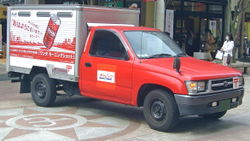 |
|
| Production | 1997–2005 |
|---|---|
| Assembly | Hino Motors, Hamura, Japan Samut Prakan, Thailand Santa Rosa, Laguna, Philippines |
| Body style(s) | 2-door truck 4-door truck |
| Layout | Front engine, rear-wheel drive / four-wheel drive |
| Engine(s) | 2.0L I4 2.7L I4 2.4L D4D turbo diesel 2.5L D-4D turbo diesel 3.0L diesel I4 |
| Transmission(s) | 5-speed manual 4-speed automatic |
| Wheelbase | Regular Cab: 2,850 mm (112.2 in) Extended Cab: 3,090 mm (121.7 in) Crew Cab: 2,855 mm (112.4 in) |
| Length | Regular Cab: 4,690 mm (184.6 in) Extended Cab: 5,035 mm (198.2 in) Crew Cab: 4,790 mm (188.6 in) |
| Width | Regular Cab & All 2WD Models: 1,665 mm (65.6 in) Crew Cab & Extended Cab: 1,790 mm (70.5 in) |
| Height |
4WD Regular Cab/Extended Cab: 1,775 mm (69.9 in) 2WD Extended & Crew Cab:1,695 mm (66.7 in) |
| Related | 4Runner/Hilux Surf TC Pickup |
Hilux was parted by this generation from Tacoma.
Tacoma spent only in facelift for a while.
Facelift
The name Tacoma comes from an Lushootseed word for the volcano Tahoma in the Cascade Mountains, known as Mount Rainier in English, which is visible from Tacoma, Washington, USA.
The Tacoma frame differs from the Hilux frame, although both appear similar from the outside. Both the Tacoma and Hilux variants are sold in Mexico.
The Tacoma pickup trucks was radically updated, with a new frame and body, new suspension, and new engines. All versions now featured coil springs in front with an independent a arm type suspension and leaf springs in back.
The Tacoma was restyled in 1998 when the front fascia and the frame were the primary changes as well as the addition of new badging. It was also restyled in 2001 when a new "double cab" (crew cab) option was added, and a flashy S-Runner was offered as well.
Engines:
- 1995-2004 2.4 L (2438 cc) 2RZ-FE 16-valve DOHC I4, 142 hp (106 kW) (4x2)
- 1995-2004 2.7 L (2693 cc) 3RZ-FE 16-valve DOHC I4, 150 hp (112 kW) (4x4)
- 1995-2004 3.4 L 5VZ-FE 24-valve DOHC V6, 190 hp (142 kW)
Thailand
Toyota shifted production from the Hilux Mighty-X (fifth generation) to the Hilux Tiger (sixth generation) in the late 1990s and made it the global export hub. The Thailand made Hilux Tiger went through the following versions: 1998-1999 - Hilux Tiger with 5L engine 2000-2001 - Hilux Tiger with 5L EFI (Electronic Fuel Injection) Engine 2001 - Hilux Tiger with 1KZ engine (short lived replaced right away with D4D engine) Late 2001- late 2004 : Hilux Tiger SportCruiser with D4D engine[4]
In 2005, Toyota has ceased the production of the JDM Hilux truck, and let this was the last generation Hilux to be available in Japan.
|
Seventh generation
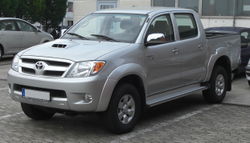 |
|
| Also called | Tacoma Hilux Vigo |
|---|---|
| Production | 2005–present |
| Assembly | Zarate, Argentina Karachi Sindh, Pakistan Chachoengsao, Thailand[5] Samut Prakan, Thailand Durban, South Africa Santa Rosa, Philippines |
| Body style(s) | 2-door truck 4-door truck |
| Layout | Front engine, rear-wheel drive / four-wheel drive |
| Engine(s) | 2.0L (134 hp) I4 1TR-FE 2.5L (100 hp) diesel I4 2.7 L (158 hp) I4 2TR-FE 3.0L diesel I4 4.0L V6 |
| Transmission(s) | 5-speed manual 4-speed automatic 5-speed automatic |
| Wheelbase | 3,085 mm (121.5 in) |
| Length | Regular Cab: 4,975 mm (195.9 in) Extended Cab: 5,255 mm (206.9 in) Crew Cab: 5,130 mm (202.0 in) |
| Width | Regular Cab & All 2WD Models: 1,760 mm (69.3 in) Crew Cab & Extended Cab: 1,835 mm (72.2 in) |
| Height | 4WD Regular Cab: 1,795 mm (70.7 in) 4WD Crew Cab & Extended Cab: 1,810 mm (71.3 in) 2WD Regular Cab: 1,680 mm (66.1 in) 2WD Extended & Crew Cab: 1,695 mm (66.7 in) |
| Related | 4Runner Fortuner Innova Prado FJ Cruiser |
Both the Tacoma and the Hilux were updated in 2005. The Tacoma was based on the new 4Runner chassis, while the Hilux rides on a refreshed version of the ladder frame found on previous versions. The new Hilux has increased in size and is now classified as a mid-size pick up. The Tacoma had a new 4.0 liter V6 engine that produces 236 horsepower (176 kW) and 266 ft·lbf (361 N·m) torque. Its design was very similar to the 4Runner.
Hilux models sold in Australian and Asian markets are built and assembled in Thailand, where the vehicle is called the Hilux Vigo, or simply Vigo. For the European, South African and Icelandic markets the Hilux is built in Durban, South Africa. As of December 2009, it is the best selling vehicle in South Africa. Those sold in South America are made in Argentina, as with the previous generation Hilux.[6] In Asia, the Hilux Vigo platform was used as the basis for Toyota's IMV program which spawned the Innova MPV and Fortuner SUV/PPV.
In Malaysia, the Hilux is only available in 2.5 L with the option of single cab or double cab. The double cab model has an automatic transmission variant. It uses the same engine as other Asian countries (in-line, 4-cylinder, 16-valve, DOHC Turbo Diesel with common rail direct injection), however engines used in Malaysia differ in their maximum output of 75 kW (101 hp) at 3600 rpm and maximum torque of 260 N·m (192 ft·lbf) at 1600-2400 rpm.
In Singapore, the Hilux is available as a single cab with the 2.5 L engine or a double cab with the 3.0 L engine. However, the engines are built in Japan (where they are also used in the Prado) instead of Argentina. Notable fleet customers include private taxi operators, for whom the double cab model offers additional load space versatility, and the Singapore Police Force, which employs it as a patrol vehicle.
Engines (markets):
- 2005 2.0 L gasoline VVT-i DOHC I4 (South Africa, Indonesia and Middle East)
- 2005 2.5 L diesel D-4D DOHC I4, 102 hp (76 kW) - 144 hp (Asia, Europe, South Africa, South America)
- 2005 2.7 L gasoline VVT-i DOHC I4, 160 hp (Australia, Arabian Peninsula, The Philippines, South Africa, USA)
- 2005 3.0 L diesel D-4D DOHC I4, Turbodiesel, commonrail 16-valve direct injection, 173 hp (127KW) (Asia, South Africa, South America, Australia, Europe). This version is made at Toyota's facility in Zárate, Argentina.
- 2005 4.0 L gasoline VVT-i DOHC V6, 228 hp (170 kW) - 236 hp (Australia, South Africa, USA)
- 2008 4.0L Supercharged DOHC V6 306 hp/225 kW (Australia only, TRD edition)
Facelift
A facelifted version of the Hilux was unveiled by Toyota's Malaysian distributors, UMW Toyota Motor, in August 2008. Toyota has released a Left Hand Drive facelifted Hilux Vigo in August 2008 while a Right Hand Drive facelifted model is expected to be released in September 2008.[7] These facelifted models were introduced to the Philippines in October 2008.
Toyota also introduced a rear access system called "Smart Cab" to replace all Xtra Cab models in E and G grade. The Smart Cab models are only for the Thailand domestic market.
|
Recreational vehicle chassis
Recreational vehicles (RV) have been built on Toyota truck chassis since the introduction of the Toyota Chinook in 1977 on a standard duty chassis until 1993 when the last Winnebago and National coaches were completed on their last remaining 1992 chassis. Since that time there have been a number of manufactures that have used the small Toyota truck chassis to build small class C motor homes including Chinook, RBR, New Horizons, Coachman, Huntsman, National (under both the Dolphin and Seabreaze names), Winnebago Industries (under both the Itasca and Winnebago name), and Gardner Pacific (under the Sunrader name). Beginning in 1986 RV manufacturers began using the heavier Toyota 1 ton cab and chassis.
Reputation
The Hilux has gained a reputation for exceptional sturdiness and reliability, even during sustained heavy use and/or abuse, and is often referred to as "The Indestructible Truck". This was further reinforced on the BBC motoring show Top Gear, when a 1988 Hilux with 190,000 miles (308,000 km) on the odometer was subjected to extraordinary abuse (in series 3, episodes 5 and 6). This consisted of driving it down a flight of steps, scraping buildings, crashing headlong into a tree, being washed out to sea, and being submerged for four hours, driving it through a garden shed, dropping a caravan onto it, hitting it with a wrecking ball, setting its cabin and bed area on fire,[8] and, finally, placing it on top of a 240-foot (73 m) block of apartments that was next destroyed by a controlled demolition.[9] Although it was now suffering from severe structural damage, the truck was still running after being repaired without spare parts, and with only the typical tools, etc. that would be found in a truck's toolbox, such as screwdrivers, motor oil, and an adjustable wrench,[10] however WD40 was used to get the engine going after it had been recovered from the sea. The Hilux currently rests as one of the background decorations in the Top Gear studio.
In the TV series of 2006, (series 8, episode 3), a Hilux was chosen by Jeremy Clarkson as his platform for creating an amphibious vehicle. With assistance, Clarkson rigged the truck with a massive outboard motor, ironically made by Honda, and steering mechanism in the pickup bed. The truck, redubbed the "Toybota", was driven by Clarkson over several miles by road and two miles (3 km) across open water, before capsizing (three meters away from the finish) during a quick turn. Once recovered, the vehicle was moved back to the Top Gear Studio, where a confident Clarkson stated that he would be the only one capable of driving his truck home, since it was the indestructible Hilux. However, Clarkson could not get the Hilux started - which led his co-hosts to believe that Clarkson had finally destroyed the "indestructible". When Clarkson turned the engine over, it produced a puffing and hissing sound as though the injectors or the heater plugs had been removed. In the 2007 series (Series 10, Episode 2), Clarkson used a Nissan pick-up (dubbed "Nissank") in a second amphibious challenge, successfully crossing the English Channel in that vehicle.
In 2007, Top Gear ran a special program in which Clarkson and James May raced a customized 2005 model Hilux to the 1996 magnetic north pole from Northern Canada against Richard Hammond using a dog sled, and won. This episode, known as the Top Gear Polar Special, made the truck the first motor vehicle to make it to the North Magnetic Pole. The Hilux used was slightly modified: larger wheels and thicker tyres were installed, a thick sump guard was installed, the front suspension was moved forward, a gun mount was installed, some powerful front lights were installed (although they were not needed) and a toilet seat (called the 'Bumper Dumper' by Clarkson) was mounted on the rear bumper.
In 2010, the Top Gear host James May drove a modified Hilux, one which had served as the camera crew's vehicle during the 2007 polar special, to approach the summit of an erupting Icelandic volcano and retrieved a fragment of volcanic lava. The Hilux was modified for this task by the installation of a simple metal "umbrella" and alcohol cooling drips for its tyres. This was filmed shortly before the stopping of all airline flights in that area due to volcanic ash expelled by the volcano (Series 15, Episode 1).
Outside of TV programs, these vehicles have been known to exceed 300,000 miles (~500,000 km) with regular maintenance. It is also notorious for being used as an improvised fighting vehicle–a "technical" – by militias and irregular military forces, especially in Third World conflicts. The Toyota War between Libya and Chad was so named because of the use of Hilux trucks as light cavalry vehicles by the army of Chad. These vehicles have also been used in the Iraq war as Improvised Explosive Devices (IED). Militias have been known to outfit this vehicle with stolen, post-Soviet Union missiles and equipment. The Toyota War saw use of the Hilux as a towing vehicle, serving to tow aircraft and tanks, including the T-62 heavy tank from the former Soviet army. There are currently 37 customized Hiluxes used by the People's Liberation Army in the Southern region of China. The Toyota Hilux has been widely used by Pakistan Army. However, Mitsubishi L200s were bought instead of sixth-generation Hilux recently to replace worn out vehicles. The New Zealand Army currently uses the Toyota Hilux for its troops in Afghanistan, as part of Operation Enduring Freedom.
In October 2007, the Swedish auto magazine Teknikens Värld performed an evasive manoeuvre (a moose test) that revealed that the manoeuvrability of Hilux pickup truck was deficient for turning sharply at moderate speeds. The truck failed the test and only the driver's skill prevented it from overturning. After the test Toyota stopped the sales of Hilux equipped with 16 inch wheels in Europe.
A world record was achieved by the support crew for the participants in the 2008/2009 Amundsen Omega 3 South Pole Race. The crew travelled in specially adapted Toyota Hiluxs modified by Arctic Trucks, completing a trip of over 5000 km from Novo, a Russian Scientific Station in Antarctica to the Geographic South Pole and back again, making them the first 4x4s to reach the South Pole. The return journey of 2500 km from the South Pole to Novo Station was completed in a record 8 days and 17 hours. [11]
A fourth generation Hilux is also the vehicle mode for the Transformers Autobots Trailbreaker and Hoist.
|
Notes and references
- ↑ 1.0 1.1 1.2 1.3 1.4 1.5 1.6 Toyota Vehicle Identification Manual. Toyota Motor Sale Co., Ltd. - Export Parts Department. 1979. 97911-79
- ↑ 2.0 2.1 2.2 2.3 2.4 "Pickups and Mini-Trucks". Pickups and Mini-Trucks (Hot Rod Magazine) 1 (5): 36. 1983.
- ↑ http://www.brian894x4.com/Hiluxgeneration2.html
- ↑ "Detailed Specs of Thailand made Hilux Tiger 1998-2004". http://www.jimsoni.com/toyota-tiger.html.
- ↑ "โตโยต้าแถลงกรณีย้ายไลน์ผลิตวีโก้-ฟอร์จูนเนอร์". Manager Online. 14 May 2010. http://manager.co.th/Motoring/ViewNews.aspx?NewsID=9530000066836. Retrieved 15 May 2010. (Thai)
- ↑ www.auto-car-shop.com Hilux 2009, came into Mercosur! - accessed 22 November 2008
- ↑ "Photos and some higlights of 2009 LHD and RHD Toyota Hilux Vigo 2009". http://www.sonirodban.com/toyota-hilux-vigo-2009.html.
- ↑ Top Gear: Killing a Toyota Part 1 BBCWorldwide on YouTube. Added: March 30, 2007
- ↑ Top Gear: Killing a Toyota Part 2 (a) BBCWorldwide on YouTube. Added: March 30, 2007
- ↑ Top Gear: Killing a Toyota Part 2 (b) BBCWorldwide on YouTube Added: March 30, 2007
- ↑ http://www.thesouthpolerace.com/index.php?ID=
External links
- Official Toyota Hilux site - UK
- Toyota Hilux Review - Motorstop.asia
- English Translations of Japanese-manufactured Hilux recalls at DogAndLemon.com
|
|||||||||||||||||
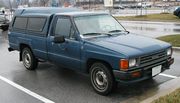
_cab_chassis_02.jpg)



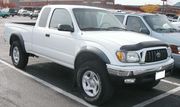
_4-door_utility_01.jpg)
_SR5_4-door_utility_01.jpg)
_4000SL_4-door_utility_01.jpg)

_(front),_Serdang.jpg)
_SR_4-door_utility_01.jpg)
_SR5_4-door_utility_01.jpg)

